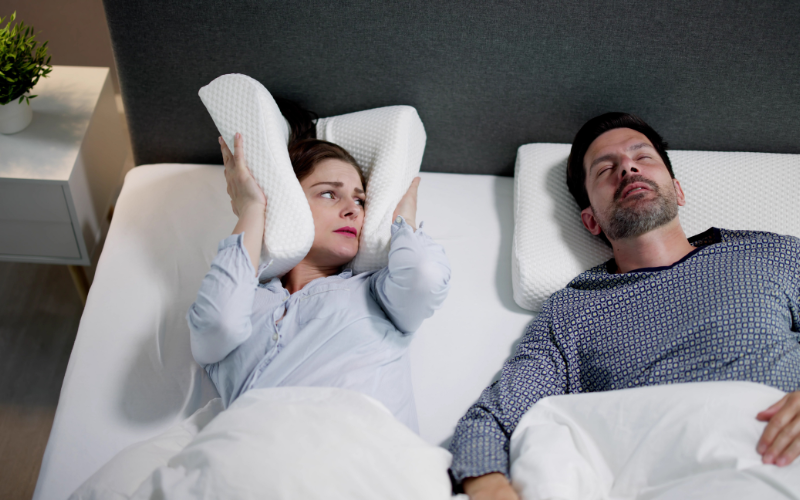
Sleep apnea is more than just a snoring problem—it’s a potentially serious condition where breathing repeatedly stops and starts during sleep. If it's not treated, it can lead to significant health issues such as heart disease, stroke, and excessive daytime fatigue.
Fortunately, advancements in medical treatments and lifestyle changes offer effective solutions. In this blog, we'll explore the top 10 sleep apnea treatments, emphasizing innovative approaches, their benefits, and the impact they can have on your overall health.
What’s Sleep Apnea?
Before diving into treatment options, it's essential to understand the two main types of sleep apnea:
- Obstructive Sleep Apnea (OSA): The most common type, caused by the relaxation of throat muscles that block the airway.
- Central Sleep Apnea (CSA): A less common form that occurs when the brain fails to send signals to muscles controlling breathing.
The symptoms for both types are often similar: loud snoring, choking during sleep, excessive daytime fatigue, and restless sleep. Now, let’s explore the treatments that can help alleviate these symptoms.
1. Continuous Positive Airway Pressure (CPAP) Therapy
CPAP therapy is often the gold standard for treating sleep apnea. It involves wearing a mask over the nose or mouth connected to a machine that delivers constant air pressure, keeping the airway open during sleep.
- Benefits:
- Effectively reduces snoring and sleep apnea episodes.
- Improves sleep quality and reduces daytime sleepiness.
- Decreases the risk of cardiovascular complications.
- Drawbacks:
- Some find the machine uncomfortable.
- Adjustment period required for consistent use.
2. Bi-level Positive Airway Pressure (BIPAP)
While similar to CPAP, BiPAP therapy provides two levels of air pressure: a higher pressure when inhaling and a lower pressure when exhaling. This makes it ideal for those with central sleep apnea or individuals who cannot tolerate CPAP.
- Benefits:
- Easier breathing for those with severe apnea or breathing difficulties.
- Better suited for patients with overlapping respiratory conditions.
- Drawbacks:
- More expensive than CPAP.
- Can still be uncomfortable for some users.
3. Oral Appliances
For those with mild to moderate obstructive sleep apnea, oral appliances can be a less invasive alternative. These custom-made devices reposition the jaw and tongue to keep the airway open during sleep.
- Benefits:
- Easy to use and portable.
- No need for bulky machines or masks.
- Drawbacks:
- May cause jaw discomfort or tooth movement over time.
- Less effective for severe cases.
4. Positional Therapy
Some individuals only experience sleep apnea when lying on their back, making positional therapy an effective option. Devices or wearable technology can encourage side-sleeping, reducing airway obstruction.
- Benefits:
- Non-invasive and simple.
- Often recommended for mild cases of sleep apnea.
- Drawbacks:
- Not effective for those with severe sleep apnea.
- Must be used consistently for effectiveness.
5. Weight Loss and Lifestyle Changes

Excess weight, particularly around the neck, can contribute to airway obstruction during sleep. Losing weight through a healthy diet and regular exercise can significantly reduce or even eliminate sleep apnea symptoms.
- Benefits:
- Reduces or eliminates the need for medical treatments.
- Improves overall health, including cardiovascular and respiratory function.
- Drawbacks:
- Requires commitment and time.
- May not completely resolve sleep apnea for everyone.
6. Surgery (UPPP, Genioglossus Advancement, and More)
Several surgical options are available for sleep apnea treatment, particularly for patients who don’t respond to other treatments. These include:
- Uvulopalatopharyngoplasty (UPPP): Removes excess tissue in the throat to widen the airway.
- Genioglossus Advancement: Repositions the tongue muscle to prevent airway collapse.
- Maxillomandibular Advancement (MMA): Repositions the jaw to enlarge the airway.
- Benefits:
- Permanent solutions for some patients.
- Effective for structural causes of sleep apnea.
- Drawbacks:
- Surgery carries risks, such as infection and recovery time.
7. Inspire Therapy (Implantable Nerve Stimulator)
Inspire therapy is an innovative treatment where a small device is surgically implanted to stimulate the nerve that controls the tongue, preventing airway blockage during sleep. The device is controlled via a remote and activates when the patient is asleep.
- Benefits:
- Minimally invasive, with no need for a mask or external device.
- Proven to be effective for many patients with moderate to severe OSA.
- Drawbacks:
- Requires surgery and implant maintenance.
- Expensive and not suitable for all types of sleep apnea.
8. Nasal Decongestants and Allergy Treatments
For some, nasal congestion or allergies can exacerbate sleep apnea by narrowing the airway. Nasal decongestants, antihistamines, or even nasal surgery can help improve airflow during sleep.
- Benefits:
- Addresses underlying issues like congestion that can worsen apnea.
- Non-invasive and easily integrated into daily life.
- Drawbacks:
- Effective only for those with apnea linked to nasal issues.
- May require ongoing treatment or medication to maintain results.
9. Hypoglossal Nerve Stimulation (HGNS)
Hypoglossal nerve stimulation is another advanced surgical option for patients with moderate to severe obstructive sleep apnea (OSA) who cannot tolerate CPAP therapy. This procedure involves implanting a device that stimulates the hypoglossal nerve, which controls tongue movement.
Being active during sleep helps keep the airway open by preventing the tongue from collapsing backward.
Benefits:
- Offers a solution for patients who don’t respond well to traditional treatments.
- No external masks or machines are required.
- Customizable settings to match individual needs.
Drawbacks:
- Involves surgery and device maintenance.
- Not suitable for patients with central sleep apnea or mild forms of OSA.
10. Lifestyle and Sleep Hygiene Changes
In some cases, improving sleep hygiene and making simple lifestyle adjustments can be an effective complementary treatment for managing sleep apnea. This includes adopting healthy sleeping habits, such as:
- Establishing a consistent sleep schedule.
- Creating a comfortable and quiet sleep environment.
- Avoiding alcohol and sedatives, which can relax throat muscles and exacerbate sleep apnea.
- Quitting smoking, which can inflame and narrow the airway.
Benefits:
- Can be implemented alongside other treatments.
- Improves overall sleep quality and well-being.
- Non-invasive and cost-effective.
Drawbacks:
- May not fully treat sleep apnea on its own.
- Requires long-term commitment and consistency.
Find The Right Treatment for You
Sleep apnea is a condition that can greatly impact your health and quality of life if it’s not treated. Fortunately, there are a variety of effective sleep apnea treatments available that can significantly improve symptoms and reduce associated risks.
From traditional therapies like CPAP to innovative options like Inspire Therapy and Hypoglossal Nerve Stimulation, each treatment comes with its own set of benefits and considerations. It’s essential to consult a healthcare professional to determine which treatment is most suitable for your specific type and severity of sleep apnea.
Whether through medical intervention or lifestyle changes, there’s hope for those struggling with sleep apnea—so don’t let it keep you up at night any longer!
